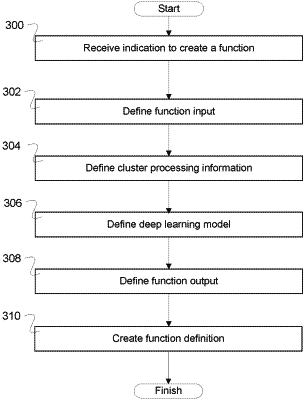| CPC G06N 3/08 (2013.01) [G06N 3/04 (2013.01); G06N 3/063 (2013.01); G06N 5/022 (2013.01); G06N 5/027 (2013.01); G06F 16/14 (2019.01); G06F 16/22 (2019.01)] | 20 Claims |

|
1. A method to create a database function, comprising:
defining a database function input;
defining cluster processing information comprising:
a performance threshold,
an indication to determine a resource allocation or a batch size of the database function through a static analysis test without executing the database function, and
an indication to perform a pretest upon execution of the database function to determine resource allocation or batch size, an indication to adjust the resource allocation or the batch size of the database function in an event that performance of the database function is below the performance threshold during execution of the database function;
defining a deep learning model through:
specification of a deep learning model object, a location of a deep learning model file, and a deep learning model framework, the deep learning model framework based on a first deep learning model object or a second deep learning model object and having a model file format and an execution engine type, and a computation based on the deep learning model framework;
defining a database function output; and
generating the database function, based at least in part on the database function input, the cluster processing information, the deep learning model, and the database function output, through:
determination of an application logic based on the deep learning model, the database function generated at least in part based on the application logic,
determination of whether the resource allocation or the batch size is indicated, and
storage of the resource allocation or the batch size as function metadata when the resource allocation or the batch size is indicated.
|